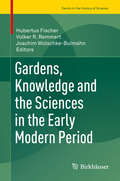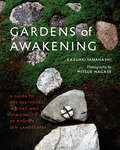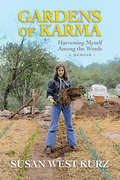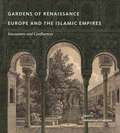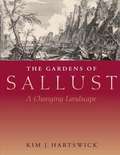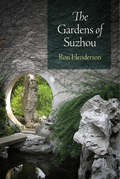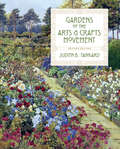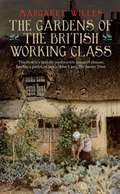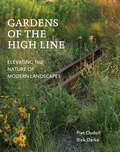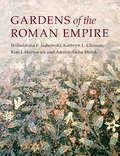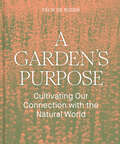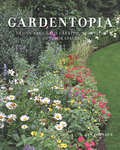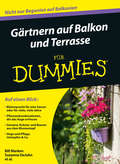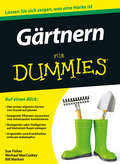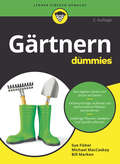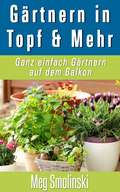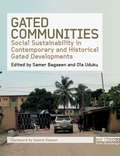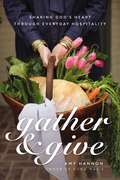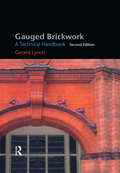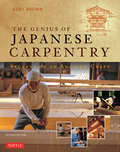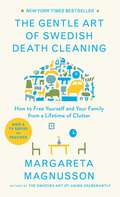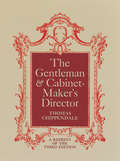- Table View
- List View
Gardens, Knowledge and the Sciences in the Early Modern Period
by Hubertus Fischer Volker R. Remmert Joachim Wolschke-BulmahnThis volume of proceedings primarily focuses on the outstanding contributions made by botany and the mathematical sciences to the genesis and development of early modern garden art and garden culture. The many facets of mathematical sciences and botany point to the increasingly "scientific" approach that was being adopted in garden art and garden culture in the early modern period. This development unfolds in interaction with philosophical, religious, political and social processes and beliefs. This volume strikingly shows that such processes are able to make use of the knowledge of nature manifested in gardens for various purposes. The conference that inspired this volume was jointly organized by the Leibniz Universität Hannover's Centre of Garden Art and Landscape Architecture (CGL) and the Bergische Universität Wuppertal's Interdisciplinary Centre for Science and Technology Studies (IZWT).
Gardens of Awakening: A Guide to the Aesthetics, History, and Spirituality of Kyoto's Zen Landscapes
by Kazuaki TanahashiRenowned artist Kaz Tanahashi reveals the deep, inner spiritual connections that Zen gardens can foster, with over 75 stunning full-color photos of the masterpiece gardens of Kyōto, Japan.Imagine yourself in Kyōto, Japan, gazing at an ancient temple garden. How would you contextualize what you are seeing? What is the history of this centuries-old contemplative art form of Zen gardening? What are its symbols and concepts?Richly illustrated with full-color photographs, Gardens of Awakening guides you through a series of Zen temple gardens, most of which were created from the fourteenth through seventeenth centuries. Some are teeming with plants and flowing water, while others have only rocks and sand. All share in the Zen aesthetics of awakening.Through essays and commentary on Mitsue Nagase&’s striking photographs, beloved Zen artist and translator Kazuaki Tanahashi presents the gardens in terms of seven qualities that arise from Zen practice: direct, ordinary, vigorous, gleaming, pivotal, nondual, and inexhaustible. Relating these qualities to the development of Zen culture and its influence on Japanese art, Gardens of Awakening invites you deep into the heart of Zen.
The Gardens of Emily Dickinson
by Judith Farr Louise CarterIn this first substantial study of Emily Dickinson's devotion to flowers and gardening, Judith Farr seeks to join both poet and gardener in one creative personality. She casts new light on Dickinson's temperament, her aesthetic sensibility, and her vision of the relationship between art and nature, revealing that the successful gardener's intimate understanding of horticulture helped shape the poet's choice of metaphors for every experience: love and hate, wickedness and virtue, death and immortality. Gardening, Farr demonstrates, was Dickinson's other vocation, more public than the making of poems but analogous and closely related to it. Over a third of Dickinson's poems and nearly half of her letters allude with passionate intensity to her favorite wildflowers, to traditional blooms like the daisy or gentian, and to the exotic gardenias and jasmines of her conservatory. Each flower was assigned specific connotations by the nineteenth century floral dictionaries she knew; thus, Dickinson's association of various flowers with friends, family, and lovers, like the tropes and scenarios presented in her poems, establishes her participation in the literary and painterly culture of her day. A chapter, "Gardening with Emily Dickinson" by Louise Carter, cites family letters and memoirs to conjecture the kinds of flowers contained in the poet's indoor and outdoor gardens. Carter hypothesizes Dickinson's methods of gardening, explaining how one might grow her flowers today. Beautifully illustrated and written with verve, The Gardens of Emily Dickinson will provide pleasure and insight to a wide audience of scholars, admirers of Dickinson's poetry, and garden lovers everywhere.
Gardens of Karma: Harvesting Myself Among the Weeds, A Memoir
by Susan West KurzIt Began in a Simple Garden . . . and Led to a Spiritual Path. Susan West Kurz's earliest memories began in a garden, where she nurtured herbs and colorful flowers, nibbled sun-drenched vegetables and ripe berries, and danced with her doll, Pinocchio. Later, she landed in another garden, that one in Germany, where she shaped her budding interest into a hugely successful career for international organic and natural skin care products. But for decades, Susan was steeped in another role-one of enabler, support system, and overall back-up singer to the alcoholics who were center stage in her life. The pain of that disease ultimately led her to Anthroposophy, her spiritual path, where she soon recognized she had been headed all along. On her subsequent journey to health and freedom, Susan continues to find inner peace in a garden.
Gardens of Renaissance Europe and the Islamic Empires: Encounters and Confluences (G - Reference, Information and Interdisciplinary Subjects)
by Mohammad GharipourThe cross-cultural exchange of ideas that flourished in the Mediterranean during the sixteenth and seventeenth centuries profoundly affected European and Islamic society. Gardens of Renaissance Europe and the Islamic Empires considers the role and place of gardens and landscapes in the broader context of the information sharing that took place among Europeans and Islamic empires in Turkey, Persia, and India.In illustrating commonalities in the design, development, and people’s perceptions of gardens and nature in both regions, this volume substantiates important parallels in the revolutionary advancements in landscape architecture that took place during the era. The contributors explain how the exchange of gardeners as well as horticultural and irrigation techniques influenced design traditions in the two cultures; examine concurrent shifts in garden and urban landscape design, such as the move toward more public functionality; and explore the mutually influential effects of politics, economics, and culture on composed outdoor space. In doing so, they shed light on the complexity of cultures and politics during the Renaissance.A thoughtfully composed look at the effects of cross-cultural exchange on garden design during a pivotal time in world history, this thought-provoking book points to new areas in inquiry about the influences, confluences, and connections between European and Islamic garden traditions.In addition to the editor, the contributors include Cristina Castel-Branco, Paula Henderson, Simone M. Kaiser, Ebba Koch, Christopher Pastore, Laurent Paya, D. Fairchild Ruggles, Jill Sinclair, and Anatole Tchikine.
Gardens of Renaissance Europe and the Islamic Empires: Encounters and Confluences
by Mohammad GharipourThe cross-cultural exchange of ideas that flourished in the Mediterranean during the sixteenth and seventeenth centuries profoundly affected European and Islamic society. Gardens of Renaissance Europe and the Islamic Empires considers the role and place of gardens and landscapes in the broader context of the information sharing that took place among Europeans and Islamic empires in Turkey, Persia, and India.In illustrating commonalities in the design, development, and people’s perceptions of gardens and nature in both regions, this volume substantiates important parallels in the revolutionary advancements in landscape architecture that took place during the era. The contributors explain how the exchange of gardeners as well as horticultural and irrigation techniques influenced design traditions in the two cultures; examine concurrent shifts in garden and urban landscape design, such as the move toward more public functionality; and explore the mutually influential effects of politics, economics, and culture on composed outdoor space. In doing so, they shed light on the complexity of cultures and politics during the Renaissance.A thoughtfully composed look at the effects of cross-cultural exchange on garden design during a pivotal time in world history, this thought-provoking book points to new areas in inquiry about the influences, confluences, and connections between European and Islamic garden traditions.In addition to the editor, the contributors include Cristina Castel-Branco, Paula Henderson, Simone M. Kaiser, Ebba Koch, Christopher Pastore, Laurent Paya, D. Fairchild Ruggles, Jill Sinclair, and Anatole Tchikine.
The Gardens of Sallust: A Changing Landscape
by Kim J. HartswickPleasure gardens, or horti, offered elite citizens of ancient Rome a retreat from the noise and grime of the city, where they could take their leisure and even conduct business amid lovely landscaping, architecture, and sculpture. <P><P>One of the most important and beautiful of these gardens was the horti Sallustiani, originally developed by the Roman historian Sallust at the end of the first century B.C. and later possessed and perfected by a series of Roman emperors. Though now irrevocably altered by two millennia of human history, the Gardens of Sallust endure as a memory of beauty and as a significant archaeological site, where fragments of sculpture and ruins of architecture are still being discovered.
The Gardens of Suzhou (Penn Studies in Landscape Architecture)
by Ron HendersonSuzhou, near Shanghai, is among the great garden cities of the world. The city's masterpieces of classical Chinese garden design, built from the eleventh through the nineteenth centuries, attract thousands of visitors each year and continue to influence international design. In The Gardens of Suzhou, landscape architect and scholar Ron Henderson guides visitors through seventeen of these gardens. The book explores UNESCO world cultural heritage sites such as the Master of the Nets Garden, Humble Administrator's Garden, Lingering Garden, and Garden of the Peaceful Mind, as well as other lesser-known but equally significant gardens in the Suzhou region.Unlike the acclaimed religious and imperial gardens found elsewhere in Asia, Suzhou's gardens were designed by scholars and intellectuals to be domestic spaces that drew upon China's rich visual and literary tradition, embedding cultural references within the landscapes. The elements of the gardens confront the visitor: rocks, trees, and walls are pushed into the foreground to compress and compact space, as if great hands had gathered a mountainous territory of rocky cliffs, forests, and streams, then squeezed it tightly until the entire region would fit into a small city garden.Henderson's commentary opens Suzhou's gardens, with their literary and musical references, to non-Chinese visitors. Drawing on years of intimate experience and study, he combines the history and spatial organization of each garden with personal insights into their rockeries, architecture, plants, and waters. Fully illustrated with newly drawn plans, maps, and original photographs, The Gardens of Suzhou invites visitors, researchers, and designers to pause and observe astonishing works from one of the world's greatest garden design traditions.
Gardens of the Arts and Crafts Movement: Revised Second Edition
by Judith B. TankardIn this revised edition of Gardens of the Arts and Crafts Movement, landscape scholar Judith B. Tankard surveys the inspirations, characteristics, and development of garden design during the movement. Tankard presents a selection of houses and gardens of the era from Great Britain and adds new examples from North America. With almost 300 illustrations and photographs, and an emphasis on the diversity of designers who helped forge the movement, this book is an essential resource for this truly distinct approach to garden design.
The Gardens of the British Working Class
by Margaret WillesThis magnificently illustrated people's history celebrates the extraordinary feats of cultivation by the working class in Britain, even if the land they toiled, planted, and loved was not their own. Spanning more than four centuries, from the earliest records of the laboring classes in the country to today, Margaret Willes's research unearths lush gardens nurtured outside rough workers' cottages and horticultural miracles performed in blackened yards, and reveals the ingenious, sometimes devious, methods employed by determined, obsessive, and eccentric workers to make their drab surroundings bloom. She also explores the stories of the great philanthropic industrialists who provided gardens for their workforces, the fashionable rich stealing the gardening ideas of the poor, alehouse syndicates and fierce rivalries between vegetable growers, flower-fanciers cultivating exotic blooms on their city windowsills, and the rich lore handed down from gardener to gardener through generations. This is a sumptuous record of the myriad ways in which the popular cultivation of plants, vegetables, and flowers has played-and continues to play-an integral role in everyday British life.
Gardens of the High Line: Elevating the Nature of Modern Landscapes
by Piet Oudolf Rick DarkeThe Gardens of the High Line is the first book devoted to the plants and planting design of New York City's iconic High Line. In its sumptuous pages, Piet Oudolf, who designed the original plantings, and Rick Darke, a leading voice in sustainable horticulture, reveal why the High Line is such an iconic example of landscape design.
Gardens of the Roman Empire
by Wilhelmina F. Jashemski Kathryn L. Gleason Kim J. Hartswick Amina-Aïcha MalekIn Gardens of the Roman Empire, the pioneering archaeologist Wilhelmina F. Jashemski sets out to examine the role of ancient Roman gardens in daily life throughout the empire. This study, therefore, includes for the first time, archaeological, literary, and artistic evidence about ancient Roman gardens across the entire Roman Empire from Britain to Arabia. Through well-illustrated essays by leading scholars in the field, various types of gardens are examined, from how Romans actually created their gardens to the experience of gardens as revealed in literature and art. Demonstrating the central role and value of gardens in Roman civilization, Jashemski and a distinguished, international team of contributors have created a landmark reference work that will serve as the foundation for future scholarship on this topic.
A Garden's Purpose: Cultivating Our Connection with the Natural World
by Félix de RosenEssays and stories to inspire us to nurture diverse, meaningful relationships with gardens and landscapes. "A garden, as Félix de Rosen suggests in this book, is not a place separate to the world but a tether to it. At a time of increasing ecological and cultural fragmentation and loss, de Rosen reminds us of the importance of the garden as a place of gentle activism and abundance, and gardening as a framework for being with the more-than-human world—engaging with care, reciprocity, and creativity. A Garden's Purpose is an important, timely book." — Georgina Reid, editor of Wonderground Journal and author of The Planthunter: Truth, Beauty, Chaos, and PlantsThe garden provides a powerful, generous way of looking at the world. Through stories and essays, this gracious volume, written in a highly accessible tone, invites readers on a journey to understand gardens as places where we build mutually beneficial relationships with the living world around us.As beautiful spaces, gardens fill us with hope and wonder. As gathering places, they nurture friendships and communities. Thoughtfully crafted, they make us pause and appreciate our surroundings. Full of edible plants, they nourish us. Full of diversity—human and non-human—they connect us with the polychromatic world in which we live. They make us feel at home in our own bodies, in our cities, and on our planet.Each chapter in this book is dedicated to a specific idea or element of the garden, from places where gardens grow (i.e., a driveway in San Francisco, a bathtub as a planter) to garden management (why some lawns need watering every few days, and some gardens can go almost a full year without irrigation) to color and texture (i.e., how fine-textured plants like grasses can be used to unify a space), and everything in between. Hundreds of gardens from all corners of the globe are included, photographed in glorious full color.Perfect for home gardeners, landscape designers, or as a gift for the gardener in your life, this is an ode to the wonder, design, and habitat of gardens, and an inspiration to nurture meaningful relationships with the natural world around us.
Gardentopia: Design Basics For Creating Beautiful Outdoor Spaces
by Jan Johnsen“Gardentopia is that rare marriage of the art of landscaping and the technical knowledge of how to compose a landscape—boiled down to readily understood and easily executed actions. This book puts you in the driver’s seat and shows you how to chart the course to your own personal garden utopia.” - Margie Grace, Grace Design Associates Any backyard has the potential to refresh and inspire if you know what to do. Jan Johnsen’s new book, Gardentopia: Design Basics for Creating Beautiful Outdoor Spaces, will delight all garden lovers with over 130 lushly illustrated landscape design and planting suggestions. Ms. Johnsen is an admired designer and popular speaker whose hands-on approach to “co-creating with nature” will have you saying, “I can do that!’ This info-packed, sumptuous book offers individual tips for enhancing any size landscape using ‘real world’ solutions. The suggestions are grouped into five categories that include Garden Design and Artful Accents, Walls, Patios, and Steps and Plants and Planting, among others. Whether you are an experienced gardener or a landscaping novice, Gardentopia will inspire you with tips such as ‘Soften a Corner”, “Paint it Black”, and “Hide and Reveal”.
The Gargoyles of Notre Dame: Medievalism and the Monsters of Modernity
by Michael CamilleMost of the seven million people who visit the cathedral of Notre Dame in Paris each year probably do not realize that the legendary gargoyles adorning this medieval masterpiece were not constructed until the nineteenth century.
Gärtnern auf Balkon und Terrasse für Dummies (Für Dummies)
by Bill Marken Suzanne DeJohnWer keinen Garten besitzt, muss nicht auf's Gärtnern verzichten. Auch auf Balkon oder Terrasse lässt sich in Töpfen und Kübeln ein kleiner, aber feiner Garten anlegen. Dieses Buch zeigt Ihnen, wie Sie die richtigen Pflanzen auswählen, sie hegen und pflegen und geschickt miteinander kombinieren, sodass sich ein harmonisches Ganzes ergibt. Es macht Vorschläge für Blumenarrangements für eine Saison oder auch eine Bepflanzung, an der Sie viele Jahre Freude haben, ohne viel Arbeit investieren zu müssen.
Gärtnern für Dummies (Für Dummies)
by Sue Fisher Michael MacCaskey Bill MarkenWenn Sie nicht nur Ihrem grünen Daumen vertrauen wollen Haben Sie ein Stück Erde, das Sie in einen Garten verwandeln möchten, aber außer der Freude an erdverschmierten Händen, sattem Grün und Farbenpracht noch recht wenig Ahnung von Gartenarbeit? Dann ist Gärtnern für Dummies das richtige Buch für Sie! Hier erhalten Sie konkrete Hilfestellung bei der Planung Ihres Gartens und der Wahl der für Sie und Ihr Stück Land passenden Pflanzen. Lernen Sie, wie Sie aus Bäumen, Büschen und Blumen ein harmonisches Ganzes schaffen und mit einjährigen und mehrjährigen Pflanzen Ihren Garten zum Blühen bringen. Außerdem enthält das Buch viele nützliche Tipps zum richtigen Gartengerät, zur Hege und Pflege der Pflanzen, zur Schädlingsbekämpfung und zum Kompostieren.
Gärtnern für Dummies (Für Dummies)
by Sue S. Fisher Michael MacCaskey Bill MarkenHaben Sie ein Stück Erde, das Sie in einen Garten verwandeln möchten, aber außer der Freude an erdverschmierten Händen, sattem Grün und Farbenpracht noch recht wenig Ahnung von Gartenarbeit? Dann ist "Gärtnern für Dummies" das richtige Buch für Sie! Hier erhalten Sie konkrete Hilfestellung bei der Planung Ihres Gartens und der Wahl der für Sie und Ihr Stück Land passenden Pflanzen. Lernen Sie, wie Sie aus Bäumen, Büschen und Blumen ein harmonisches Ganzes schaffen und mit einjährigen und mehrjährigen Pflanzen Ihren Garten zum Blühen bringen. Außerdem enthält das Buch viele nützliche Tipps zum richtigen Gartengerät, zur Hege und Pflege der Pflanzen, zur Schädlingsbekämpfung und zum Kompostieren.
Gärtnern in Töpfen und Mehr
by Meg Smolinski Sabine CretellaGärtnern in Töpfen ist ein toller und einfacher Weg, um praktisch das ganze Jahr über frisches Gemüse und Obst anzubauen. Dieses Buch hilft sowohl Neulingen als auch erfahrenen Gärtnern mit tollen Tipps und Tricks das Beste aus ihrem Topfgarten zu machen.
Gated Communities: Social Sustainability in Contemporary and Historical Gated Developments
by Samer Bagaeen Ola UdukuGated Communities provides a historic, socio-political and contemporary cultural perspective of gated communities. In doing so it offers a different lens through which to view the historical vernacular background of this now global phenomenon. The book presents a collection of new writing on the issue by an international and interdisciplinary group of contributors. The authors review current thinking on gated communities and consider the sustainability issues that these contemporary 'lifestyle' communities raise. The authors argue that there are links that can be drawn between the historic gated homesteads and cities, found in much of the world, and today's Western-style secure complexes. Global examples of gated communities, and their historical context, are presented throughout the book. The authors also comment on how sustainability issues have impacted on these communities. The book concludes by considering how the historic measures up with the contemporary in terms of sustainability function, and aesthetic.
Gather and Give: Sharing God’s Heart Through Everyday Hospitality
by Amy Nelson HannonNow more than ever, the world is hungry to gather and thirsty for connection.Many of us wish to share a meal, share our faith, and share our lives with others. We want to open our home to friends and neighbors for the sake of meaningful community, but we&’re overwhelmed with hospitality hang-ups. How do I extend an invitation? What will they think of my house or the food? Our welcome has been influenced by the messages of the world that tell us hospitality is about our ability to be, host, live, and cook a certain way.In Gather & Give, Amy Hannon inspires you to embrace the simple hospitality of the Bible that values connection more than perfection and people more than presentation. Amy shares scriptural principles and practical ideas to make everyday hospitality a natural, joy-filled part of your life. You will feel encouraged and equipped to view your home as:a holy wellspring of welcome to offer hope to a weary world;a strategic springboard for ministering to those around you; andthe perfect platform for influencing others for Christ.Find freedom in knowing that the hospitality of the Bible is uncomplicated and effortless, that a welcome can be used by God to share His love and hope with the world, and that there is abounding joy in following the Lord in His hospitality command. Whether preparing shrimp and grits for a crowd or picking up barbecue with new neighbors, you can invite with intention, plate with purpose, and love others well.
Gauged Brickwork
by Gerard LynchGauged brickwork is a term used to describe the superior finish required in the details of an important brickwork elevation, such as moulded reveals, arches, string courses and other forms of ornamentation. This is achieved through shaping the individual bricks to produce a high degree of regularity, accurate dimensions and extreme fineness in the joints. This practical handbook combines simple diagrams and photographs to describe each stage of the process, from rubbing, cutting and shaping the bricks to laying and carving them. It emphasizes the importance of this skill in repairing and repointing rubbed and gauged brickwork and the damage that can be done by those unskilled in the craft. The second edition of this standard reference work has been substantially updated with new material, including additional photographs and illustrations to explain the various procedures and applications. It also now offers a fascinating and detailed historical perspective on the development of this important craft. The insights gleaned from this revised edition will be extremely valuable to architects and builders involved in conserving and repairing gauged brickwork, and also to those who are required to commission new decorative work to a high standard.
The Genius of Japanese Carpentry
by Azby BrownThis new edition of this Azby Brown architecural classic contains a new preface by Brown, fully revised chapters, along 25% new photography and in color for the first time.An extraordinary and ambitious work of architectural reconstruction is underway in twenty-first century Nara. The Genius of Japanese Carpentry is the story of the twelve-hundred-year-old Yakushiji monastery and the dedicated modern-day craftsmen who are working to restore what has been lost to the depredations of time, fire, and warfare.In the eighth century, anonymous carpenters first erected the intricately-designed timber temples and pagodas that compose the Yakushiji Buddhist monastery. Then as today, these buildings were considered marvels of architectural elegance and traditional Japanese craftsmanship. Although the full restoration will not be complete until 2030, one of the main temples, the Picture Hall, has been completely reconstructed, employing the original methods, architectural style, and largely the same woodworking technology as its predecessors. Azby Brown chronicles the Picture Hall's painstaking restoration through photographs, extensive interviews with the carpenters and woodworkers, and original drawings based on the plans of Japanese master carpenter Tsunekazu Nishioka. An inspiring testament to the craftsmen, their dedication to excellence, and their philosophy of work as personal fulfillment, The Genius of Japanese Carpentry offers detailed documentation of this singular project and a moving reminder of the humanity that bridges past and present.
The Gentle Art of Swedish Death Cleaning: How to Free Yourself and Your Family from a Lifetime of Clutter (The Swedish Art of Living & Dying Series)
by Margareta MagnussonA charming, practical, and unsentimental approach to putting a home in order while reflecting on the tiny joys that make up a long life.In Sweden there is a kind of decluttering called döstädning, dö meaning “death” and städning meaning “cleaning.” This surprising and invigorating process of clearing out unnecessary belongings can be undertaken at any age or life stage but should be done sooner than later, before others have to do it for you. In The Gentle Art of Swedish Death Cleaning, artist Margareta Magnusson, with Scandinavian humor and wisdom, instructs readers to embrace minimalism. Her radical and joyous method for putting things in order helps families broach sensitive conversations, and makes the process uplifting rather than overwhelming. Margareta suggests which possessions you can easily get rid of (unworn clothes, unwanted presents, more plates than you’d ever use) and which you might want to keep (photographs, love letters, a few of your children’s art projects). Digging into her late husband’s tool shed, and her own secret drawer of vices, Margareta introduces an element of fun to a potentially daunting task. Along the way readers get a glimpse into her life in Sweden, and also become more comfortable with the idea of letting go.
The Gentleman and Cabinet-Maker's Director
by Thomas ChippendaleThomas Chippendale (1718-79) was the most famous and most skilled of England's master cabinet-makers. So synonymous with excellence in design and craftsmanship was he that his name has been given to the most splendid period of English furniture design.In 1774, Chippendale issued a catalogue of all his designs, a magnificent compilation of 160 engraved plates representing the prevailing furniture styles, particularly the French (Louis XXV), Gothic, and Chinese-manner pieces for which he was best known. The Gentleman and Cabinet-Maker's Director, the most important and thorough catalogue of furniture designs that had ever been published in England, was enormously influential, spreading quickly throughout the Continent and the colonies and guiding the style and construction of furniture everywhere. A second edition was formed the following year, and a third in 1762. Today this classic collection is a very rare and highly valued work.This volume is an unaltered and unabridged republication of the 1762 edition of The Gentleman and Cabinet-Maker's Director. The articles of furniture depicted are extremely varied: chairs, sofas, canopy and dome beds, window cornices, breakfast tables, shaving tables, commodes, chamber organs, cabinets, candle stands, cisterns, chimney pieces, picture frames, frets, and other decorations. The plates contain elegant drawings that show the unique combination of solidity of construction and lightness and grace that was the Chippendale trademark, along with many construction diagrams, elevations, and enlargements of moldings and other details. In addition to the plates, this volume also includes a supplement of photographs of sixteenth-century Chippendale-style pieces, including some executed by Chippendale, complete captions to the photos, and a short biographical sketch of Chippendale by N. I. Bienenstock, editor of Furniture World.The Gentleman and Cabinet-Maker's Director is an indispensable guide for antiquarians, furniture dealers, and collectors, and a treasury of ideas for today's designers. Art lovers and other readers will also find it a delightful browsing book.
